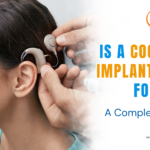Imagine a world where everyday activity, music, and the voices of loved ones gradually replace the sound of quiet. A cochlear implant can help many people who have profound hearing loss achieve this change. For people who don’t benefit from conventional hearing aids, this cutting-edge medical technology has completely changed the way that hearing treatment is provided. This tutorial will explain what a cochlear implant is, how it functions, and its potentially transformative potential, supported by statistics and professional opinions.
What is a Cochlear Implant?
A cochlear implant is an internal electrical device implanted to bypass non-functioning inner ear structures and directly stimulate the auditory nerve. Unlike hearing aids, which work by amplifying sound, cochlear implants change sound waves to electrical signals and provide a sensation of sound for individuals with profound hearing loss.
The unit has two main components:
- External Processor: Worn behind the ear, it captures the sounds and transmits them to the internal implant.
- Internal Implant: Implanted underneath the skin, it stimulates the nerve of the ear.
Around 700,000 people worldwide have received cochlear implants, according to the National Institute on Deafness and Other Communication Disorders (NIDCD).
How Does a Cochlear Implant Work?
The four steps of cochlear implantation are:
- Sound Capture: The microphone captures environmental sounds.
- Signal Processing: The sound is filtered and digitized by the processor.
- Transmission: Signals are transmitted from a magnet to the internal implant.
- Stimulation: The cochlear electrodes stimulate the auditory nerve, which is interpreted by the brain as sound.
This device is of most use in patients with damage to the hair cells, which are responsible for 90% of sensorineural hearing loss.
Who Needs a Cochlear Implant?
Cochlear implantation is recommended in patients with:
- Severe-to-profound sensorineural hearing loss (hearing thresholds ≥70 dB).
- Restricted benefit from hearing aids (i.e., performance ≤50% on sentence recognition tests).
1.5 billion individuals worldwide have hearing loss, with 430 million suffering from disabling ones (World Health Organization). Yet, only 1-2% of them are eligible for cochlear implants—a disparity that indicates a greater need for awareness.
Pediatric Applicants:
- Implants are available for children as young as 12 months.
- Early implantation (under 3 years) is 90-95% successful with speech and language.
Adult Candidates:
- Adults with progressive hearing loss have 80% speech recognition improvement after implantation.
Cochlear Implant vs. Hearing Aids: Key Differences
While hearing aids amplify, cochlear implants replace defective auditory function. Consider:
- Effectiveness: Mild-to-moderate loss is optimally treated with hearing aids. Severe-to-profound is treated with cochlear implants.
- Sound Clarity: 30 percent of hearing-aid users and 70 percent of cochlear implant users, have clear, noise-free hearing.
The Cochlear Implant Surgery: What to Expect
- Evaluation: Audiologic testing, imaging, and consultation determine candidacy (2-4 weeks).
- Surgery: An outpatient procedure that takes 2-4 hours with a cure rate of 95%. Mild side effects (e.g., infection) occur in 5-10% of patients.
- Activation: The activation takes place 2-6 weeks after the surgery. The sounds at first are mechanical, but the brain adjusts in 3-6 months.
- Rehabilitation: Auditory training guarantees maximum results, particularly for children.
Advantages and Success Rates
- Adults: 80% show significant improvement in communication.
- Children: Over 90% acquire normal language skills with early implantation.
- Quality of Life: 70% of the subjects report enhanced social interaction and mental health.
Potential Risks and Considerations
Although safe, cochlear implants pose minimal risks:
- Meningitis: Less than 0.1% risk from post-operative vaccinations.
- Device Failure: Incidence is 3-5%, typically requiring revision surgery.
- MRI Compatibility: The new models are MRI-compatible to 3.0 Tesla.
Advances in Cochlear Implant Technology
Modern developments are:
- Bluetooth Connectivity: Allows for direct streaming from devices.
- Slimmer Electrodes: Preserve residual hearing in 50% of recipients.
- AI Processors: Boost speech recognition in noise by 30%.
Research is also making access easier, with prices (typically 30,000− 30,000−50,000) now encompassed in 80% of U.S. cases.
If you’re looking for a Best Hearing aid center for you or Hearing impairment service in Kolkata, then this is the right place for you.
Contact us
Life with a Cochlear Implant
Customers usually refer to the experience as “life-changing.” Adaptation tips:
- Visit regular audiology appointments.
- Practice listening drills.
- Join support groups for shared experience.
Did You Know? Over 60% of recipients are able to enjoy music following implantation, something previously deemed unlikely.
Conclusion
Cochlear implants have revolutionized the lives of many individuals with severe hearing loss, providing opportunities for clearer communication, independence, and improved quality of life. Consultation with an audiologist is crucial to determine if this life-changing technology is the right solution.
For more information and personalized consultation, contact your local audiology center or hearing specialist.
Only 5% of eligible candidates currently seek implantation. Raising awareness could help millions rediscover sound’s profound beauty.
At Aural Care, we understand that every individual’s hearing needs are unique. That’s why we offer a personalized approach to care, taking the time to understand your specific needs and goals. Our team is committed to providing you with the highest quality care and service, and we are here to support you every step of the way.
Google Location: GB7, 822, Rajdanga Main Road . Opp. GST Bhawan. Kol 700107


